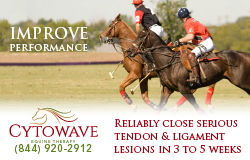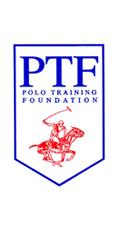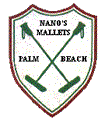Meet David “Pelón” Stirling, the newest member of the Coca-Cola team, competing in this year’s 26-goal
season in Florida. The 10-goal Uruguayan has
made a name for himself in several polo
playing countries. Most recently, he was
named MVP of the Argentine Open, playing
for the La Dolfina team as it competed against
Ellerstina. Not only did La Dolfina win the
Open, it notched back-to-back Triple Crown
victories. Alice Gipps sat down with Pelón in
England this summer to learn more about his
life on the polo road.
Where are the main polo seasons you
play professionally?
Argentina, U.S., England and
sometimes Spain. The season in the
States starts in January and runs until
April 20, then I have 15 days holiday with
my family before heading to the U.K.
In the 15 days off, we go to Argentina,
where we have a house, or to Chile, as my
wife José is Chilean. The English season
finishes the middle of July. Some years we
head straight to Spain or Santa Barbara for
August, but out of those two, mainly Spain,
as I have family there and both the seasons
are on at the same time. Then, I head back
to Argentina for the main season there.
In which location abroad have you
spent the most time?
In the U.K., where I have been playing
the most. I finished school and started
university at Oxford Brooks in October
2000.
|
Palermo’s MVP
By Ernesto Rodriguez • Photos by Sergio Llamera
On December 6, David
Stirling had just completed
a grand final match in
Palermo, contributing to
the 14-12 triumph of La
Dolfina Hope Funds
against Ellerstina Piaget to
lift the most coveted crown
on the planet, and complete
the second consecutive
Triple Crown. But, the
afternoon had a nice
surprise for the Uruguayan,
who turned 40 on January
4: he was chosen MVP of
the match.
The incredulous look on
his face the moment he was
named MVP, made it clear
he was surprised. “I could
not believe it. There were so
many great players on that
field. It could not be a joke,
but I thought the
announcer was wrong! I
never imagined I could get
this prize on such an
important and historic day
for the polo world. It is an honor and I
am thankful to my organization and the
people who are behind me all year,
Especially my cousin Jejo and my groom
Justo,” explained Pelón.
"In 2014, I played in Dubai, Palm
Beach, then I went to Argentina, traveled
to England, then I went through
Sotogrande and back to Argentina. Now I
have to rest. We will be with my family for
some time in Young, the Uruguayan city
where I was born, which is about 200
miles from the capital Montevideo. We
are also going to Chile, where my wife
María José is from. I want to enjoy my
children, Vicente (2 years old) and Amalia
(1), for a while,” said the player who
joined the team from Cañuelas in 2009.
I sat down with Pelón, shortly after his
win.
What is your feeling after
winning the final match?
I know we did not offer the
best possible match because
Ellerstina tried to [change the
flow of the game]. From the
outside, you should not have
enjoyed it. But, it was a final and we
had to win anyway. We could not
[come up] short, [it is] just a step of
the glory. That’s why it was celebrated
so much. At the Tortugas and
Hurlingham finals, we played much
better. But after Palermo, we happily
went home with the cup.
Were you surprised
with the amount of
Uruguayan flags in
Palermo?
I’m getting used to
that part of the
Dorregos tribune
(seating area in
Palermo), it seems like
Uruguay’s embassy!
While in my country,
polo is not very
popular, so my fellow
Uruguayans travel to
the Open final
weekend to enjoy the
game. It makes me feel
good, Before and after
the game, they ask for
photos. It makes me
feel as famous as the football players Diego Forlán and
Luis Suárez. Luckily, my achievements
allow Uruguayan polo to be better
recognized, and some [players are trying
to get a team] to play the 2015 Coronation
Cup. It would be an honor to lead the
Celeste (light blue) shirt in England.
How do you process this moment of
success?
What is happening is unthinkable.
I dreamed I would get to play in
Palermo. When I arrived, I wanted to
play a final. And when I could play
one, win. But what I have done is
beyond expectations. I have been
very lucky and took my chances
when they were presented to me.
If you asked me this 10 years ago,
I could not have imagined.
What is the secret to La
Dolfina’s triumphs?
We have known each other
in and out of the field over
time. So, we got better
slowly, overcoming errors
and making the team a bit
stronger every time.
Besides having a lot of
talent, my teammates trust their
life with Milo Fernandez Araujo, La
Dolfina’s coach. Milo got into our heads
that losing was forbidden. He is the fifth
player on the team, and all season is
plugged in 100 percent. Many victories
are also his merit. That is why this team
has not yet reached our ceiling, we want
to play and keep adding wins. The hard
part will be not getting a triumph, but we will keep trying to win. We already
validated our seasonal wins by adding the
Jockey Club Open. Now we are thinking
about the 2015 Triple Crown.
What does it mean to you to be next
to Adolfo Cambiaso?
Adolfito is everything to me. In 2007,
we met playing in Palm Beach and he
opened his arms to me. He took me
around the world and helped me grow.
The guy is enviable. He has nothing more
to gain because he won everything, but he
is still more eager than a beginner. He
does not think about his huge talent, he is
trying to be the best, as I imagine Roger
Federer and Lionel Messi are. He is the No. 1 in the sport and I try to learn in
every situation that I share with him. I
feel privileged.
He has also helped me with the horses.
It makes me very happy to help the team
he founded, being a little bit bigger. That
is my way of thanking him for all he gave
me in life. |
|
|
|
I brought my first few horses in the
season of 2001, which was the [same year
as the outbreak of] foot and mouth
disease. I remember it well. I stayed with
my horses at Beaufort with the
Tomlinsons and played medium goal with
them. Since then, I have come to England
every year.
In 2002, the Geebung team offered me
to play the Gold Cup in the U.K., and in
2003 I started the high goal in Spain.
Sotogrande is like my second home. I
moved there when I was 6 years old, as my
father ran the polo there for a long time,
so I have many school friends. After
England, which is more polo concentrated, in Spain there is more to
do. The weather is great, you have the
beach, which Jose and the kids enjoy, and
a house with a swimming pool. The rest
of my family are also normally there that
time of the year so it’s a big gathering. We
went for the 2014 season and always have
a lot of fun during that month.
America is also very nice, but I go
there on and off. The first year I went was
in 2007 with Crab Orchard and Adolfo
[Cambiaso], then two years in a row I was
part of the Pony Express team. I had a
couple of years without going, then I was
invited back to play with Valiente for a
couple of seasons. This season I will play
with Gillian Johnston’s Coca-Cola team.
How do you like living abroad?
We like it because you move to a place
for two-and-a-half months at a time. You
get used to a base and settle in. That is
the good thing about polo. It is not like
tennis or golf where you do one week
here, one week there. There is time to get
the kids into school. Everyone treats you
well. We always have a nice place to stay.
That helps a lot.
What do you do in down time?
Our life revolves mainly around the
stables and polo. Occasionally, we go to
the beach and also do some shopping.
When we are in Florida, I will take the
family to Disney or Miami for an outing.
In the U.K. it is a very similar
schedule. Most days are spent at the barn
or at polo. This year, we were in Cowdray,
which is quieter with more countryside. I
like it. Manor farm is very nice.
It is further from London for Jose so
she probably prefers the Windsor area,
but I really enjoy it as we get more time as
a family. This season we have been to
Portsmouth, and the animal farms are a
favorite with the kids. Especially when
the sun is out. It is a great country. I
started school in the U.K. in ‘98 but I
never went to polo! I only played in
Sotogrande when I went for holidays.
How do you manage to build up a
good string of horses in each country?
That is probably the most difficult thing
about playing abroad. I started my own
breeding program very late, so the oldest
youngsters are only just 5 years old and just
starting to play young-horse chukkers now.
So far, I’ve always had to buy horses to get
organized in those three places. It is very
difficult to be well mounted, but I try the
best I can by traveling a lot to find really
good horses. Everywhere I have a set of
horses, but my main bases now are in
Argentina and England. I will always ship
two or three ponies to play in America
every year that I go.
Do you take horses from Argentina to
America?
I prefer to take them from England, as
it is the same hemisphere. The horses
travel very well. From Argentina it is more
difficult for them to get settled in.
I’ve done seasons when I’ve taken
horses and then shipped them back after
but I try to leave a base in the U.S.
because if you start traveling with them a
lot, you exhaust them.
Do you take the good ones home to
breed?
I’ve been doing that for the last few
years. My mares that get injured or are
too old to play, I take to Argentina, where
I now have a very nice bunch of
broodmares to take embryos from.
I also take one or two of the better
ones I find abroad back to Argentina to
play as well. Finally, last year I was very
well organized for the Argentine season. I
took three from England and three from
the U.S. to play the Open and all six of
the new horses played amazingly well.
From the U.K. I took Jive from Ben Eely,
Renato from Luke Tomlinson and Secret
from Henry Brett. From the States, I took two mares from Memo Gracida that I had
originally bought in Argentina and took
to play in the U.S. and another mare I
bought from Adolfo, an American
Thoroughbred.
How many foals do you have per year?
I am breeding around 40 fillies per
year. We have the embryos sexed, and all
are out of mares that play the Open or are
retired mares.
Quite a few of the stallions I use are
from Cambiaso and I’ve bought a
percentage of them at auctions. I take a
bit of everything and mix it around to see
if I manage to get one good one! The
breeding program operates from a rented
farm in San Antonio De Areco, which is
not that far from our house in Cañuelas.
Do you have a manager?
My cousin Jejo, who works in Spain,
has always been with me throughout my
career, helping me out and organizing
everything. My other main guy is Justo,
my groom. He started with me when I
first played in England. For the last three
years, he has stayed in Argentina with all
the breeding and takes care of the horses
during the Argentine season. He has had
a very important role in my career.
The same grooms have worked with
me for a long time. I have four or five
guys that already know me, my habits and
how I like the horses to perform. They go
two months before the season starts to
each location to get the horses ready, and
then I normally take someone with me to
help with the riding and playing
chukkers. The last few years this has been
Tomi Ruiz Guinazu.
What does your wife José think of
traveling around to all the different
countries?
She enjoys it. Everyone is always very
good to us and her friends are in the same
places [we go]—Juan Martin’s wife, Adolfo’s
wife, Pablo’s wife. With all the children in
once place together, we have a good time.
She copes well. She is also a good rider but
now I keep her busy with the babies, so I
don’t have to buy her horses!
Do you return to Uruguay at all?
Since I married José, we return to
Uruguay less and less. Every time we have
some holidays we go to Chile. She is
following me around the whole year so we
go and spend some time with her family.
They also come and visit us abroad. The
farm in Uruguay is really close, only a
three-and-a-half hour drive from Buenos
Aires, so if it rains during the season we
get in the car and go for a couple of days.
What set-up do you have at La
Dolfina?
We have a house, a polo field and the
stables. It has all just been finished and
we lived in the house for the first time last
season, so that was great to finally move
into our own place.
How do you keep fit for playing
abroad?
I travel with my trainer Alejo
Menchon. We call him ‘Petiso.’ He travels
with us all year round. He is a great guy,
a good person to have around and he tries
to keep me fit. I give him a hard time but
once in a while the hard work pays off!
After every practice and game he
stretches me and we train every day.
What are your plans for the next
couple of years?
Hopefully, I will keep on playing with
La Dolfina. We are having a great time
with the team and organization. I have
been based in La Dolfina since 2008. I
like the area in Cañuelas because it is
quiet, not as crowded as Pilar. The idea is
to keep playing there, having fun, but be
as successful as possible. I will continue
to play competitive polo both in England
and the States. It is very difficult as you
always have to be improving your set of
horses, but I enjoy it a lot. I’ve done it
now for a while and I don’t get tired of the
traveling as I’m with my family and we all
enjoy the polo.
Photos and words by Alice Gipps |









